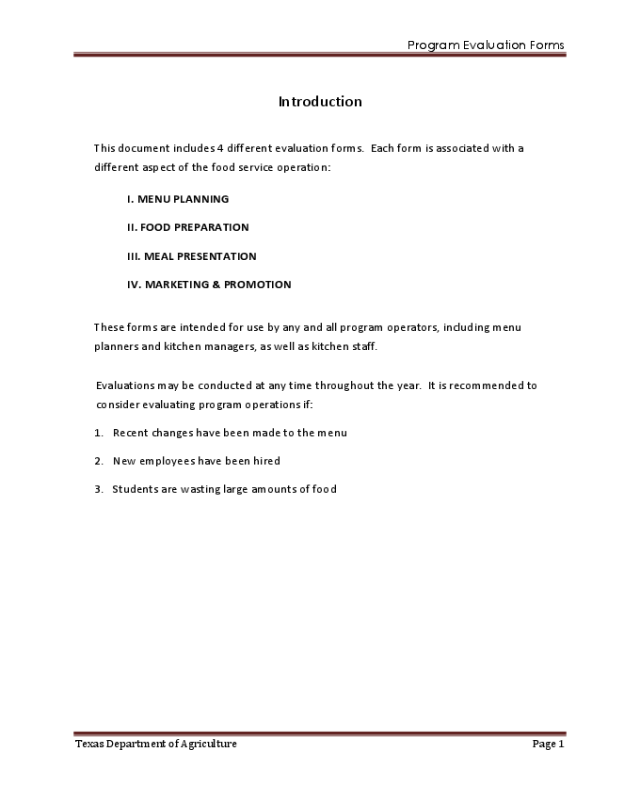Fillable Printable Detailed Program Evaluation Forms
Fillable Printable Detailed Program Evaluation Forms

Detailed Program Evaluation Forms

Program Evaluation Forms
Texas Department of Agriculture Page 1
Introduction
This document includes 4 different evaluation forms. Each form is associated with a
different aspect of the food service operation:
These forms are intended for use by any and all program operators, including menu
planners and kitchen managers, as well as kitchen staff.
Evaluations may be conducted at any time throughout the year. It is recommended to
consider evaluating program operations if:
1. Recent changes have been made to the menu
2. New employees have been hired
3.
Students are wasting large amounts of food
I. MENU PLANNING
II. FOOD PREPARATION
III. MEAL PRESENTATION
IV. MARKETING & PROMOTION

Program Evaluation Forms
Texas Department of Agriculture Page 2
A Guide:
How to Interpret Evaluation Form Results
Step 1: Assign each answer on the selected evaluation form with one of the following
values:
Step 2: Add up all the answers to all the questions on the selected evaluation form.
Step 3: Divide the number from Step 2 by the number of questions on that form (for
example, there are 18 question on the Menu Planning evaluation form). The range this
answer falls into represents the average score.
Step 4: Visit the Boost Meal Appeal webpage on www.squaremeals.org for suggestions on
how to improve the visual appeal and taste of school meals that comply with the Federal
standards.
Always = 3 Sometimes = 2 Never = 1
Below Average Average Above Average
1.00 – 1.49 1.50 – 2.49 2.50 – 3.00

Program Evaluation Forms
Texas Department of Agriculture Page 3
Circle Always, Sometimes, or Never to answer the following questions.
I.
Menu Planning Evaluation Form
1. The menu includes a variety of bright and
attractive colors
Always Sometimes Never
2. The menu includes a variety of textures
(crisp; firm; crunchy; soft; smooth)
Always Sometimes Never
3. The menu includes a variety of preparation
methods (raw; sautéed; grilled; baked)
Always Sometimes Never
4. The menu includes a variety of hot and
cold foods
Always Sometimes Never
5.
The menu includes a variety of flavors
(bitter and sweet; mild and strong)
Always Sometimes Never
6.
The menu includes a variety of shapes and
sizes
Always Sometimes Never
7. Garnishes are planned for menu items Always Sometimes Never
8.
The menu provides a daily variety of choices
from each food component group
Always Sometimes Never
9.
The menu provides a weekly variety of
choices from each food component group
Always Sometimes Never

Program Evaluation Forms
Texas Department of Agriculture Page 4
10.
New menu items are available often Always Sometimes Never
11.
The same foods items are planned two or
more days in a row
Always Sometimes Never
12. Less popular items are paired with popular
items to improve their acceptability
Always Sometimes Never
13. Unfamiliar foods are offered repeatedly Always Sometimes Never
14. Unfamiliar and less popular foods are
prepared and offered in a variety of ways
Always Sometimes Never
15.
Unpopular foods are evaluated (taste tests;
student surveys)
Always Sometimes Never
16. Students are given the opportunity to
provide feedback about menu items
(comment cards; focus groups)
Always Sometimes Never
17. The menu includes items students have
suggested or requested
Always Sometimes Never
18.
You would eat the menu items offered in
your cafeteria
Always Sometimes Never

Program Evaluation Forms
Texas Department of Agriculture Page 5
Circle Always, Sometimes, or Never to answer the following questions.
II.
Food Preparation Evaluation Form
1. The intended texture of the food is
considered during cooking
Always Sometimes Never
2.
Batch cooking is used to maintain color and
brightness of vegetables on the line
Always Sometimes Never
3.
Quality food items are used to prepared
meals
Always Sometimes Never
4. Food items with different textures are used
to prepare meals
Always Sometimes Never
5. Food items are cooked to proper
temperatures
Always Sometimes Never
6.
Overcooked foods are still served on the
line
Always Sometimes Never
7.
Production staff taste meals before serving
in order to ensure they are a good quality,
correct temperature, and flavorful
Always Sometimes Never
8. Staff follow recipes when preparing food Always Sometimes Never

Program Evaluation Forms
Texas Department of Agriculture Page 6
Circle Always, Sometimes, or Never to answer the following questions.
III.
Meal Presentation Evaluation Form
1. The serving line is clean and free of debris Always Sometimes Never
2. Fresh fruits are displayed in an appealing
manner on the serving line
Always Sometimes Never
3.
Students are able to easily grab fruit and
vegetable items while going through the line
Always Sometimes Never
4. Fruits and vegetables look fresh and bright in
color
Always Sometimes Never
5. Cooked vegetables become overcooked while
being held on the line and appear dull
Always Sometimes Never
6.
Garnishes complement the flavor, color, and
texture of the foods on the line
Always Sometimes Never
7. A variety of bright and attractive colors are
served on the line daily
Always Sometimes Never
8. Whole fruit or vegetables with bruises,
gashes, and bumps are served on the line
Always Sometimes Never
9.
There is adequate lighting to highlight food
items on the serving line
Always Sometimes Never
10. The food smells good Always Sometimes Never
11. Overall, all foods look appetizing on the line Always Sometimes Never
12.
Trays look neat and clean Always Sometimes Never

Program Evaluation Forms
Texas Department of Agriculture Page 7
13.
Employees offer assistance to students, when
needed
Always Sometimes Never
14. Employees smile while serving students Always Sometimes Never
15. Employees encourage students to try fruits
and vegetables served on the line
Always Sometimes Never
16.
Students approach employees with questions
or comments about the food
Always Sometimes Never
17. Employees are responsive to students’
questions and comments
Always Sometimes Never
18. Hot food items are held above 140 ºF Always Sometimes Never
19.
Cold food items are held below 40 ºF Always Sometimes Never
20. Frozen items are held below 0 ºF Always Sometimes Never
21. You would enjoy eating the food items
served at your school
Always Sometimes Never

Program Evaluation Forms
Texas Department of Agriculture Page 8
Circle Always, Sometimes, or Never to answer the following questions.
IV.
Marketing & Promotion Evaluation Form
1. Handouts, fliers, posters, or samples are
used to encourage the consumption of
menu items
Always Sometimes Never
2. Handouts, fliers, posters, or taste tests are
used to encourage students to eat fruit and
vegetable items
Always Sometimes Never
3. Students show interest or excitement
towards promotions
Always Sometimes Never
4. New ideas for promotions are encouraged
among the food service employees
Always Sometimes Never
5.
Food items that are promoted sell more Always Sometimes Never
6.
You are proud of the menu planning and
promotional work at your school
Always Sometimes Never



